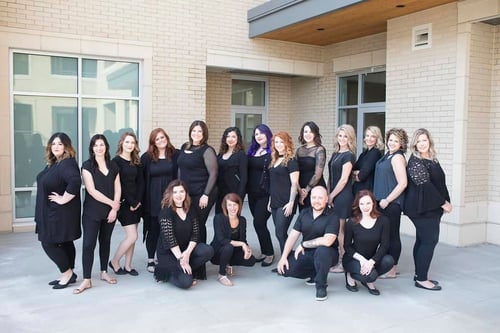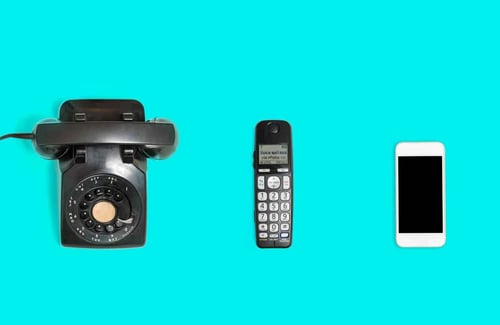
*This is a guest post from Beyond The Technique.
Our contributor, Shana Dee, is a Georgetown, DC Master Stylist with over 16 years of experience in the salon and wedding industry. In addition to Shana’s numerous achievements, she worked with President Obama’s sister and sister-in-law for the 2013 Inauguration! Shana Dee truly believes in sharing her knowledge and experience with other professionals. Beyond the Technique is excited to share Shana Dee’s Six Steps to a Winning Consultation!
Step 1: Ask Direct Questions
Let’s start with an example of a badquestion to ask a client sitting in your chair: “So, what are you wanting today?” While this question seems sincere and helpful, it is actually an ineffectivequestion because it results in a rather vague answer from your client.
So, how do you avoid ineffective questions and vague answers from clients? Ask direct questions!By asking direct questions, you are ensuring that the client is expressing what needsto happen with their hair.
To make sure that your next consultation is a winning one, Shana Dee offers some examples of direct questions that she asks her own clients:
- What look are you wanting to change about your color?
- What styles have you tried before? Longer or shorter?
- When you are at home styling your hair, what areas do you struggle with?
- When you are scrolling through Instagram, are you drawn to certain hair colors and styles?
- What color have you had in the past that made you feel so gorgeous? This is Shana’s personal favorite!
Another strategy that Shana Dee uses to truly understand what the client wants is to ask about past styles, such as:
- What did you like about the last color and cut that we did?
- If you could change anything about the way that we did your style last time, what would it be?
Asking these questions makes the client feel like they’re in control of their hair, even though the Stylist is the one creating the look. Also, Shana points out that these questions allow you—the Stylist—to make it OKAY for the client to tell you if they didn’t like what you did before.
Shana’s final tip about asking direct questions during a consultation is, always try to stay away from negative questions such as: “Well, what colordidn’t you like?” Stylists should always try to focus on positivity and keeping the client in a positive mindset!
Step 2: The Nonverbals
Many of us have heard statistics that most of our communication is nonverbal and, in fact, is conveyed through body language. To have a winning consultation, you must be conscious of both your body language and your clients’!
To ensure that Shana Dee can observe her client’s nonverbal cues, she never puts a cape on her client before giving a consultation. That seems simple, right? Shana recommends doing the consultation not-caped, so you can observe the client’s full body. When asking direct questions (see Step 1),Shana can observe if her client’s nonverbal cues demonstrate uneasiness or openness. If the client is nervous, they tend to close their body inward and become smaller. On the other hand, open body language conveys a feeling of relaxation and ease.
Another significant nonverbal cue is where you choose to stand during the consultation. While doing a consultation, Shana Dee chooses to stand infrontof her client rather than behind the chair. Standing behind the chair places the Stylist in an authority position which can make it harder for the client to open-up and feel at ease. By standing in front of your client, you can chat with the client just like you were catching-up with a friend. Always remember that your nonverbal signals should make the client feel as comfortable as possible.
Despite your best efforts to make your client comfortable, there are times when a client is reluctant to open up and will appear nervous. In these instances, Shana Dee recommends putting these insecurities on the table and asking some more direct questions–surprise! For instance, if you noticed that your client’s fists were clenched or they were fidgeting with their hands, you could ask: “I noticed that your hands were clenched when we were talking about that. Are you sure that you’re comfortable with me cutting your hair that short?” By noticing these nonverbal indications, Shana is giving her client the opportunity to change her mind, or reassure Shana that she is nervous, but wants to take the risk! Shana Dee reminds us that: “When you let the client go into what they are notsaying, that is when you find your gold mines of information.”
Step 3: You’re a Stylist, Not a Savior
Learn how to say no! As a stylist, you’ve done consultations and thought: “I can do it. I can do it.” Then, you look at the hair a bit more and realize: “Wait, nothing can save this!” Shana Dee insists that you must learn that some hair cannot be saved, and being a professional means saying no sometimes.
Stylists have said it a million times: “You can’t take dark brown hair and turn it to blonde in one day.” Sometimes, clients will try to bully you into performing a service that you are not comfortable with by saying things like: “Well, so-and-so did it at Salon XYZ. How come you can’t do it?” As a professional, Shana Dee reminds youto feel comfortable and confident in saying no and referring the client to another salon.
To explain why a client’s hair cannot change from dark brown to blonde in a single day, Shana Dee shows her clients several pictures of Khloé Kardashian’s transition from dark brown hair to blonde. Even with the amazing colorist, Tracey Cunningham, working on Khloé’s hair, it took about three steps over a year’s time to make the transition. Showing the pictures helps demonstrate the whybehind taking color one step at a time.
Shana Dee reminds you that: you really do know what is best, and you should recommend what you think is best for the client.
Step 4: Compliment, Compliment, Compliment!
This is Shana Dee’s absolute favorite step to a winning consultation! She loves this step so much, that she recommends all stylists compliment your client within the first five seconds of seeing her.For instance, when you see your client waiting for you, you can greet her by saying: “Hi! It is soo good to see you! I love your hair! Tell me how you styled it today; it looks so pretty on you!”
By immediately complimenting your client, it creates a conditioned feeling of positive energy as soon as they see you. Plus, it always gives your clients something great to talk about when they are out with friends! As the saying goes, people will never forget how you made them feel.
But, believe Shana Dee that the chance to compliment your client does not end in the waiting area! When you finally go behind the chair to touch and move the hair, there is another great opportunity to compliment. The first thing that Shana does is say: “Oh my gosh, your hair is just so pretty! I love it! Look at all this shine that is still in your hair. You do such a good job of taking care of it at home. Are you still using that shampoo and conditioner that you got last time?” Not only is this a great compliment which boosts your client’s confidence, but it reminds them about purchasing more shampoo. Complimenting is a win-win for client and stylist alike! The opportunities to compliment are truly endless—simply endless!
Step 5: Money, Money, Money
You’ve got to talk about money! Shana Dee’s best money advice is to get comfortable with your own ability to talk about money. She believes that being comfortable with money has nothing to do with our clients, but everything to do with the way that the Stylist feels about money.
One strategy to become more comfortable talking about money is to educate your clients about how much certain products and services cost. Shana quickly points out that this does not mean rattling off a list of the prices for toners and hair color. Instead, she demonstrates to the client how many steps it will take to reach their desired outcome.
To do so, she uses another nonverbal gesture—your hands! Shana Dee suggests getting out your hand and saying: “So, you want this balayage. We’re going to hand-paint, then we’re going to go through and add some low-lights.” Is your hand still out?!Then, start counting off: one, two, three, with your fingers. “Then, I’ll have to rinse and tap your roots to blend the color really well. Finally, we are going to tone that. That’s about four steps to give you the gorgeous color of your dreams. Does that sound about right?” After your client agrees, you say “Ok, so for those four steps, it is going to be this price_____.”
If your client hesitates about the price, tries to haggle with you, or seems uncomfortable at that price point, feel comfortable referring her to another Stylist that better matches her needs. If Stylists at your salon find themselves in this predicament, you should check out one of Beyond the Technique’s sponsors: Meet Your Stylist. Meet Your Stylist is a one-of-a-kind survey on your salon’s website that matches clients to your stylists. Your new clients will be paired with her top three matches at your salon who are also in her price point. Suggesting that your new client fill out the Meet Your Stylist survey ensures that both you and your client are comfortable with money!
As always, being a professional means being able to express your price and being okay with it. Shana advocates for sticking to your standard, understanding your value, and knowing what you are worth.
Step 6: Educate
Clients don’t know, what they don’t know. Shana Dee loves educating her clients and believes that all Hairstylists should deliver their knowledge in a way that can be easily understood.
A common example of this type of conversation is when a client who has dark hair wants blonde hair. After the client explains her request, she adds: “But, I don’t want any red in my hair.” Like Shana Dee, hair colorists know that as soon as you lift the hair, the underlying pigment is going to be exposed, and that color will be a combination of straight-red, red-orange, yellow-orange, or yellow.
To educate her clients about color, Shana explains that color is on a scale from 1 to 10 where 1 is black and 10 is blonde. Then, she will look at her client’s hair and say something like: “You’re a level 7.” Then, she plays a quick learning game with her client by saying something like: “When I open up your cuticle and lighten it up, there’s an invisible color in there and guess what color it is? Well, it’s red!” When the client continues to insist that they don’t want any red in their hair, you can say: “But, your hair already has red in it.” In this easy example, you are educating the client about hair color, andyou will not be blamed for red in the hair.
When you’re telling a client no, tell them yesat the same time. Even though you’re saying noto what they thinkthey can have, you are saying yesto the possibility of what is going to look amazing on them!
Shana Dee encourages everyone to follow her on Instagram @hairbyshanadee, so she can “start lovin’ on you!” To get more industry advice, make sure to follow Beyond The Techniqueand listen to the weekly podcast.
Listen to the full interview with Shana Dee on Episode 45 of Beyond The Technique’s podcast.
Related Posts

Photos Make or Break Your Website
We’re back with our four-part series on tips for your salon website. During the month of February, I’m sharing some of my best website-building secrets.
Read More of Photos Make or Break Your Website
You’ve Got to Have a Good Team Page
Hello again! We’re back with the final piece of our four-part series on tips for your salon website. During the month of February, I have been sharing some of my best website-building secrets and this week I’m bringing it home with our final tip rega…
Read More of You’ve Got to Have a Good Team Page
Two Ways to Reduce Water Waste at Your Salon
Let’s face it, due to the nature of our business, we use a ton of water each and every day. The cost of our water usage doesn’t come cheap, and while we’re not asking you to stop shampooing your guests, wasting water does take a toll on both the envi…
Read More of Two Ways to Reduce Water Waste at Your Salon
Tips and Tricks for Booking Clients Over the Phone
Welcome back!
Read More of Tips and Tricks for Booking Clients Over the Phone

Comments
0 Comments